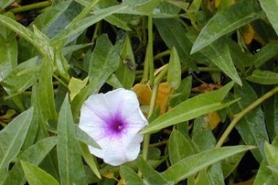Water spinach, swamp morning-glory
(Ipomoea aquatica)
This plant can form a large, dense, floating mat of intertwined stems that shade submerged aquatic and emergent vegetation. Small fragments of this plant can produce new plants with a fast growth rate of approximately 4 inches per day. This presents a threat to rivers, lakes and wetlands.
Other names for this plant include:
- Common names: Kangkong, river spinach, Chinese spinach, water convolvulus
- Scientific names: Ipomoea reptans; Ipomoea subdentata; Convolvulus reptans
Classification in Wisconsin: Prohibited
- Ecological Threat
-
- Dense and tangled mats of fast-growing vegetation can obstruct water flow and access to open water.
- Water spinach can grow in various habitats, such as lakes, ponds, wetlands and streams, shading out native plants important for fish and wildlife.
- The floating vegetation mats formed by water spinach can create stagnant water below that is ideal habitat for breeding mosquitoes.
- Identification
-
Leaves: Water spinach leaves are usually green and arrowhead or lanceolate in shape. The leaves grow alternately on the plant's stems, 2 to 6 inches long and up to 3 inches wide.
Flowers: Typically look like "morning glory" flowers. They are trumpet-shaped and showy, white to pale pink or lilac in color and grow singly or in small groups.
Fruits & seeds: Fruits are an oval or spherical capsule, woody at maturity, 0.5 inches wide; each capsule holds 1-4 grayish seeds. The pods and seeds can easily float and travel to spread new plants.
Roots: Roots are found at the nodes of the stems. Water spinach easily forms new plants when stem fragments break off and take root.
Stems: The stems are hollow and trailing, usually up to 3 meters (9 feet) but often much longer. The stems are herbaceous and have a milky sap. The limbs float in tangled mats where the plant grows on the water.
Similar species: Other species of Ipomoea or Convolvulus such as field bindweed, sweet potato or morning glory have identical flowers and leaves but lack hollow floating stems.
- Distribution
-
Currently, there have been no reports of water spinach in Wisconsin. Have you seen it? Please send us a report.
- Control
-
Mechanical: Not feasible to cut as the plant readily spreads from fragments. Hand-pulling is one option if all details are collected and destroyed.
Chemical: Aquatic-approved formulas of 2,4-D or glyphosate have had varying levels of success.
- Resources
- Sources for content:
- Florida Bureau of Invasive Plant Management: Weed Alert: Water Spinach [exit DNR]
- Invasive Species Specialist Groups: Global Invasive Species Database



